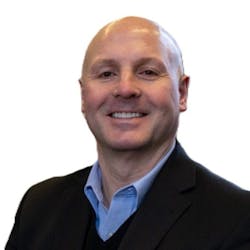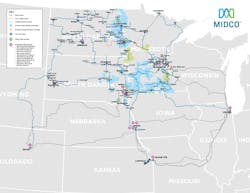Midco targets businesses and hyperscalers with new 400G wavelength service
Key Highlights
- Midco's new 400G wavelength services cater to business and service provider customers with increasing data transfer needs.
- The company has secured contracts with businesses requiring core network connections to distributed locations, highlighting market demand.
- Significant investments since 2021 have expanded and upgraded Midco’s fiber network across the Midwest, improving coverage, quality, and reliability.
- Midco maintains low latency and high QoS by delivering services over its own fiber infrastructure connecting major hubs like Chicago and Denver.
- The company aims to attract hyperscalers expanding into the Midwest by providing high-speed lit and dark fiber solutions, leveraging its strategic network locations.
Midco is giving its long-haul fiber network another role by serving up 400G wavelength services for its business and service provider customers.
Although new to the 400G game, Midco is seeing “rapidly increased demand” from its business customer base that requires this speed level.
Justin Hebda, Midco’s VP of Business Sales, said it had closed contracts “for 10 of these solutions with businesses who need to connect their core network to widely distributed locations.”
AI drives gigabit wavelength service purchases
One of the continuing trends in the wavelength segment is 100G and 400G speed services. Driven by hyperscalers, data center connectivity, cloud providers, and enterprises with heavy data transfer requirements, Vertical Systems Group noted in its 2024 U.S. Wavelength Services LEADERBOARD that customer demand for 400 Gbps wavelength services is increasing. Today, major providers offer 100 Gbps waves throughout their footprints and are ramping 400 Gbps installations, but the 800 Gbps wavelength service segment has been slower to take off.
Midco’s move into 400G is timed well.
Vertical Systems Group noted in its 2024 U.S. Wavelength Services LEADERBOARD that “customer demand for 400 Gbps Wave services is solidly increasing, driven by hyperscalers, data center connectivity, cloud providers and enterprises with heavy data transfer requirements.”
Focus on network expansion
Midco’s 400G wavelength offering follows significant investments in the network’s speed and capacity.
The service provider has positioned itself to take Midco’s network already covers the heart of this region, from North Dakota, South Dakota, Minnesota, Kansas and beyond.
Jeff Sanders, director of wholesale for Midco, said the service provider has evolved from its roots in cable TV in response to growing data service demands.
“The networking and infrastructure that’s required to support this exponential growth taking place in recent years has taken Midco from that regional cable TV provider to what we believe is a significant network player in the upper Midwest,” he said. “Over time, we have expanded through organic growth and through acquisition to operate throughout five states and will soon approach 23,000 miles in fiber infrastructure, which is all done based upon the desire to serve customer needs throughout our footprint.”
Since 2021, the company has been upgrading and expanding its fiber network across the Midwest. The service provider said the expansion is not just about increasing coverage but about enhancing the quality and reliability of the network for future demands.
It appears that Midco’s efforts are paying off.
Last year, Midco demonstrated less than 20 milliseconds of latency from Spearfish, SD, to Chicago, IL, on its MEF 3.0-certified network during testing.
What enables Midco to maintain latency levels and provide QoS for business and wholesale customers is that it delivers services over its own fiber network.
Pao Lo, vice president of network engineering at Midco, said in a blog post that Midco’s advantage in serving businesses is that “we have our own fiber connections to major hubs like Chicago and Denver.”
Meeting hyperscaler demands
Business customers aren’t the only entities that will be able to take advantage of Midco’s 400G wavelength service.
Midco is also keen on targeting hyperscaler data center opportunities in the Midwest territories where it has network operations.
As hyperscalers look to expand into the Midwest with the growing advent of AI, they will require a mix of high speed wavelength services as well as dark fiber.
Through its ongoing fiber investments, Midco has positioned itself to be a key supplier of lit and dark fiber solutions for hyperscalers that are expanding into the Midwest.
Sanders said the location of its network in the Midwest to major markets has become an attraction to hyperscalers. “Our long-haul network connects customers to major points of presence sites such as Minneapolis, Omaha, Chicago, and Denver, allowing the transmission of massive volumes of voice, video, and data at reliable 400G speeds,” he said.
Dark fiber’s role
Being a supplier to data centers, Midco is also seeing growing interest in dark fiber services.
Like its managed services, Midco’s dark fiber service offers a unique, tailored solution.
Sanders sees dark fiber as part of the next evolution in the hyperscaler and carrier space. “Dark fiber is the more sought-after as the preferred end solution,” Sanders said. “When we look at it, traditional networks were not built with these new applications in mind.”
When the initial fiber networks from Sprint and others were built in the 1980s, the focus was on delivering long-distance voice services. One of the drawbacks was that these networks leveraged SONET with lower fiber strand counts.
Today, data center providers and other carriers are overplanning the amount of capacity they are deploying because they don’t know what’s next.
“Had these early networks been built with Ethernet, they would have been well positioned,” Sanders said. “Now, you are seeing a need for thousands of counts of fiber because no one knows the ceiling. Everyone wants to make sure what they are putting in the ground is going to carry them for the foreseeable future.”
Sanders added that while traditional data centers were mainly about housing equipment and providing power, the emergence of hyperscalers is creating a new set of demands.
“Back in the day, data center operators wanted to show me their facilities, but everything all looked the same,” he said. “These hyperscalers are building purpose-built campuses, which need infrastructure and power, and people and policy are dictating where they are taking up residency.”
Tailor-made solutions
Regardless of the business need, Midco is focused on providing a tailored fit for each of its customers.
What makes Midco a compelling choice for hyperscalers that are looking to scale is its geography.
Hebda said that having developed a fiber network that serves key parts of the Midwest, it has positioned itself to become a service source for hyperscaler data center providers looking to build in new markets.
“The nature of these businesses is they are attracted to the Midwest,” Sanders said. “Fortunately, we have invested in those capabilities and now we are seeing the boom because of the colder climate and land availability, so we’re well placed to receive those businesses and serve them.”
But the demands Midco sees from wholesale customers, particularly hyperscalers, are not just about mere speed.
Hebda said hyperscalers have complex needs that require a more consultative approach, or what he calls a tailor-made solution. “Gone are the days when you can apply old-fashioned telco approaches to a solution,” he said. “Everything is tailor-made.”
He added that while the traditional telecom mentality of selling services was like going to a department store and buying a suit off the rack, that might require some alterations to achieve the right fit, which is done by a tailor. “Midco’s business and wholesale services division has become cutters,” Hebda said. “To tailor-make a suit, you must be an efficient cutter, and that’s what they have become.”
Sanders agreed and added to the analogy that suits on the rack are becoming scarce or more difficult to source. “A lot of the network infrastructure in our region is old and very highly billed, meaning capacity is not readily available on all routes,” he said. “What we’re seeing is organizations come and ask us to provide inter-mile solutions.”
Whereas a multi-site business used to be able to call up a national carrier and get all of the routes they needed, the reality is that those same routes have become congested and limited in capacity. These limitations reflect not only the new demands but also the fact that these routes were based on legacy designs.
“Midco can leverage network assets we have and connect to national POPs that are peripheral to our footprint, including Chicago, Denver, Omaha, and Minneapolis, and be able to not only provide capacity, but also unique paths throughout the geography,” Sanders said. “This has become a point of interest in the market. Our existing and new customer targets are telling us the routes we’re designing are unique than what’s in the market today.”
For related articles, visit the Business Topic Center.
For more information on high-speed transmission systems and suppliers, visit the Lightwave Buyer’s Guide.
To stay abreast of fiber network deployments, subscribe to Lightwave’s Service Providers and Datacom/Data Center newsletters.
About the Author
Sean Buckley
Sean is responsible for establishing and executing the editorial strategy of Lightwave across its website, email newsletters, events, and other information products.



